Evaluation of the Thermal Performance of Fly Ash Foam Concrete Containing Phase Change Materials (PCMs)
Abstract
:1. Introduction
2. Materials and Methods
2.1. Materials
2.2. Mix Proportions
2.3. Mechanical Properties
2.4. Differential Scanning Calorimetry (DSC)
2.5. Thermal Conductivity
2.6. Experimental Program for Heat Cycle Test
2.7. Procedure for Preparing the Heat Cycle Test
3. Experimental Results and Discussion
3.1. Compressive Strength Test
3.2. Density Tests
3.3. DSC Test and Thermal Analysis
3.4. Thermal Conductivity
3.5. Thermocycle Analysis
4. Conclusions
- Mechanical testing revealed that both PCM28D-30% and PCM-43D-30% exhibit sufficient mechanical properties for various applications, including ALC panels with a required compressive strength of 3 MPa.
- Regarding the DSC test results, the energy storage capability of PCM foam concrete increases with a higher PCM content.
- The thermal conductivity results showed a decrease in thermal conductivity with increasing amounts of PCM composites.
- The thermocycle analysis demonstrated a favorable performance for the PCM foam concrete types, maintaining temperatures within the desired ranges for extended periods.
Author Contributions
Funding
Data Availability Statement
Conflicts of Interest
References
- IEA. Buildings. License: CC BY 4.0ings. IEA: Paris, France, 2022. Available online: https://www.iea.org/reports/buildings (accessed on 8 June 2023).
- World Energy Outlook. 2022. Available online: www.iea.org/t&c/ (accessed on 25 May 2023).
- Far, C.; Far, H. Improving energy efficiency of existing residential buildings using effective thermal retrofit of building envelope. Indoor Built. Environ. 2019, 28, 744–760. [Google Scholar] [CrossRef]
- Lotfabadi, P.; Hançer, P. A Comparative Study of Traditional and Contemporary Building Envelope Construction Techniques in Terms of Thermal Comfort and Energy Efficiency in Hot and Humid Climates. Sustainability 2019, 11, 3582. [Google Scholar] [CrossRef]
- Gan, V.J.L.; Lo, I.M.C.; Ma, J.; Tse, K.T.; Cheng, J.C.P.; Chan, C.M. Simulation optimisation towards energy efficient green buildings: Current status and future trends. J. Clean. Prod. 2020, 254, 120012. [Google Scholar] [CrossRef]
- Hawes, D.W.; Feldman, D.; Banu, D. Latent heat storage in building materials Objectives of research in thermal storage building materials. Energy Build. 1993, 20, 77–86. [Google Scholar] [CrossRef]
- Hekimoğlu, G.; Nas, M.; Ouikhalfan, M.; Sarı, A.; Kurbetci, Ş.; Tyagi, V.; Sharma, R.; Saleh, T.A. Thermal management performance and mechanical properties of a novel cementitious composite containing fly ash/lauric acid-myristic acid as form-stable phase change material. Constr. Build. Mater. 2021, 274, 122105. [Google Scholar] [CrossRef]
- Tyagi, V.V.; Kaushik, S.C.; Tyagi, S.K.; Akiyama, T. Development of phase change materials based microencapsulated technology for buildings: A review. Renew. Sustain. Energy Rev. 2011, 15, 1373–1391. [Google Scholar] [CrossRef]
- Zhao, L.; Wang, H.; Luo, J.; Liu, Y.; Song, G.; Tang, G. Fabrication and properties of microencapsulated n-octadecane with TiO2 shell as thermal energy storage materials. Sol. Energy 2016, 127, 28–35. [Google Scholar] [CrossRef]
- Giro-Paloma, J.; Martínez, M.; Cabeza, L.F.; Fernández, A.I. Types, methods, techniques, and applications for microencapsulated phase change materials (MPCM): A review. Renew. Sustain. Energy Rev. 2016, 53, 1059–1075. [Google Scholar] [CrossRef]
- Liu, F.; Wang, J.; Qian, X. Integrating phase change materials into concrete through microencapsulation using cenospheres. Cem. Concr. Compos. 2017, 80, 317–325. [Google Scholar] [CrossRef]
- Hunger, M.; Entrop, A.G.; Mandilaras, I.; Brouwers, H.J.H.; Founti, M. The behavior of self-compacting concrete containing micro-encapsulated Phase Change Materials. Cem. Concr. Compos. 2009, 31, 731–743. [Google Scholar] [CrossRef]
- Ahmad, M.R.; Chen, B.; Shah, S.F.A. Investigate the influence of expanded clay aggregate and silica fume on the properties of lightweight concrete. Constr. Build. Mater. 2019, 220, 253–266. [Google Scholar] [CrossRef]
- Gencel, O.; Nodehi, M.; Hekimoğlu, G.; Ustaoğlu, A.; Sarı, A.; Kaplan, G.; Bayraktar, O.Y.; Sutcu, M.; Ozbakkaloglu, T. Foam Concrete Produced with Recycled Concrete Powder and Phase Change Materials. Sustainability 2022, 14, 7458. [Google Scholar] [CrossRef]
- Gencel, O.; Bayraktar, O.Y.; Kaplan, G.; Arslan, O.; Nodehi, M.; Benli, A.; Gholampour, A.; Ozbakkaloglu, T. Lightweight foam concrete containing expanded perlite and glass sand: Physico-mechanical, durability, and insulation properties. Constr. Build. Mater. 2022, 320, 126187. [Google Scholar] [CrossRef]
- Khan, Q.S.; Sheikh, M.N.; McCarthy, T.J.; Robati, M.; Allen, M. Experimental investigation on foam concrete without and with recycled glass powder: A sustainable solution for future construction. Constr. Build. Mater. 2019, 201, 369–379. [Google Scholar] [CrossRef]
- Gencel, O.; Nodehi, M.; Bayraktar, O.Y.; Kaplan, G.; Benli, A.; Gholampour, A.; Ozbakkaloglu, T. Basalt fiber-reinforced foam concrete containing silica fume: An experimental study. Constr. Build. Mater. 2022, 326, 126861. [Google Scholar] [CrossRef]
- Bat-Erdene, P.E.; Pareek, S. Experimental Study on the Development of Fly Ash Foam Concrete Containing Phase Change Materials (PCMs). Materials 2022, 15, 8428. [Google Scholar] [CrossRef]
- Frigione, M.; Lettieri, M.; Sarcinella, A. Phase Change Materials for Energy Efficiency in Buildings and Their Use in Mortars. Materials 2019, 12, 1260. [Google Scholar] [CrossRef]
- Alawadhi, E.M. Thermal analysis of a building brick containing phase change material. Energy Build. 2008, 40, 351–357. [Google Scholar] [CrossRef]
- Hasan, M.I.; Basher, H.O.; Shdhan, A.O. Experimental investigation of phase change materials for insulation of residential buildings. Sustain. Cities Soc. 2018, 36, 42–58. [Google Scholar] [CrossRef]
- Microtek. Available online: https://www.microteklabs.com/ (accessed on 18 September 2023).
- JIS A 6201; Japanese Industrial Standard of Fly Ash. Japanese Standard Association: Tokyo, Japan, 1991.
- JIS A 1108; Compressive Strength Test Methods for Concrete. Japanese Standard Association: Tokyo, Japan, 2018.
- Kheradmand, M. Incorporation of hybrid phase change materials in plastering mortars for increased energy efficiency in buildings. Ph.D. Thesis, Universidade do Minho, Braga, Portugal, 2016. [Google Scholar] [CrossRef]
- Andrássy, Z.; Szánthó, Z. Thermal behaviour of materials in interrupted phase change. J. Therm. Anal. Calorim. 2019, 138, 3915–3924. [Google Scholar] [CrossRef]
- He, B.; Martin, V.; Setterwall, F. Phase transition temperature ranges and storage density of paraffin wax phase change materials. Energy 2004, 29, 1785–1804. [Google Scholar] [CrossRef]
- Fatahi, H.; Claverie, J.; Poncet, S. Thermal Characterization of Phase Change Materials by Differential Scanning Calorimetry: A Review. Appl. Sci. 2022, 12, 12019. [Google Scholar] [CrossRef]
- JIS H 8453; Measurement Method for Thermal Conductivity of Thermal Barrier Coating. Japanese Standard Association: Tokyo, Japan, 2018.
- Baccilieri, F.; Bornino, R.; Fotia, A.; Marino, C.; Nucara, A.; Pietrafesa, M. Experimental measurements of the thermal conductivity of insulant elements made of natural materials: Preliminary results. Int. J. Heat. Technol. 2016, 34, S413–S419. [Google Scholar] [CrossRef]
- Dakhli, Z.; Chaffar, K.; Lafhaj, Z. The Effect of Phase Change Materials on the Physical, Thermal and Mechanical Properties of Cement. Science 2019, 1, 27. [Google Scholar] [CrossRef]
- Eddhahak, A.; Drissi, S.; Colin, J.; Caré, S.; Neji, J. Effect of phase change materials on the hydration reaction and kinetic of PCM-mortars. J. Therm. Anal. Calorim. 2014, 117, 537–545. [Google Scholar] [CrossRef]
- Kheradmand, M.; Azenha, M.; De Aguiar, J.L.B.; Krakowiak, K.J. Thermal behavior of cement based plastering mortar containing hybrid microencapsulated phase change materials. Energy Build. 2014, 84, 526–536. [Google Scholar] [CrossRef]
- Chen, X.; Wei, S.; Wang, Q.; Tang, M.; Shen, X.; Zou, X.; Shen, Y.; Ma, B. Morphology prediction of portlandite: Atomistic simulations and experimental research. Appl. Surf. Sci. 2020, 502, 144296. [Google Scholar] [CrossRef]
- Xian, G.; Liu, Z.; Wang, Z.; Zhou, X. Study on the Performance and Mechanisms of High-Performance Foamed Concrete. Materials 2022, 15, 7894. [Google Scholar] [CrossRef]
- Eddhahak-Ouni, A.; Colin, J.; Drissi, S.; Neji, J. Analysis by Differential Scanning Calorimetry of concrete modified with microencapsulated phase change materials. In Proceedings of the 2013 International Renewable and Sustainable Energy Conference (IRSEC), Ouarzazate, Morocco, 7–9 March 2013. [Google Scholar]
- Huang, X.; Zhu, C.; Lin, Y.; Fang, G. Thermal properties and applications of microencapsulated PCM for thermal energy storage: A review. Appl. Therm. Eng. 2018, 147, 841–855. [Google Scholar] [CrossRef]
- Meshgin, P.; Xi, Y. Multi-scale composite models for the effective thermal conductivity of PCM-concrete. Constr. Build. Mater. 2013, 48, 371–378. [Google Scholar] [CrossRef]
- Qiao, L.; Li, N.; Luo, L.; He, J.; Lin, Y.; Li, J.; Yu, L.; Guo, C.; Murto, P.; Xu, X. Design of monolithic closed-cell polymer foamsviacontrolled gas-foaming for high-performance solar-driven interfacial evaporation. J. Mater. Chem. A Mater. 2021, 9, 9692–9705. [Google Scholar] [CrossRef]
- Wi, S.; Yang, S.; Park, J.H.; Chang, S.J.; Kim, S. Climatic cycling assessment of red clay/perlite and vermiculite composite PCM for improving thermal inertia in buildings. Build. Environ. 2020, 167, 106464. [Google Scholar] [CrossRef]
- Cui, H.; Tang, W.; Qin, Q.; Xing, F.; Liao, W.; Wen, H. Development of structural-functional integrated energy storage concrete with innovative macro-encapsulated PCM by hollow steel ball. Appl. Energy 2017, 185, 107–118. [Google Scholar] [CrossRef]
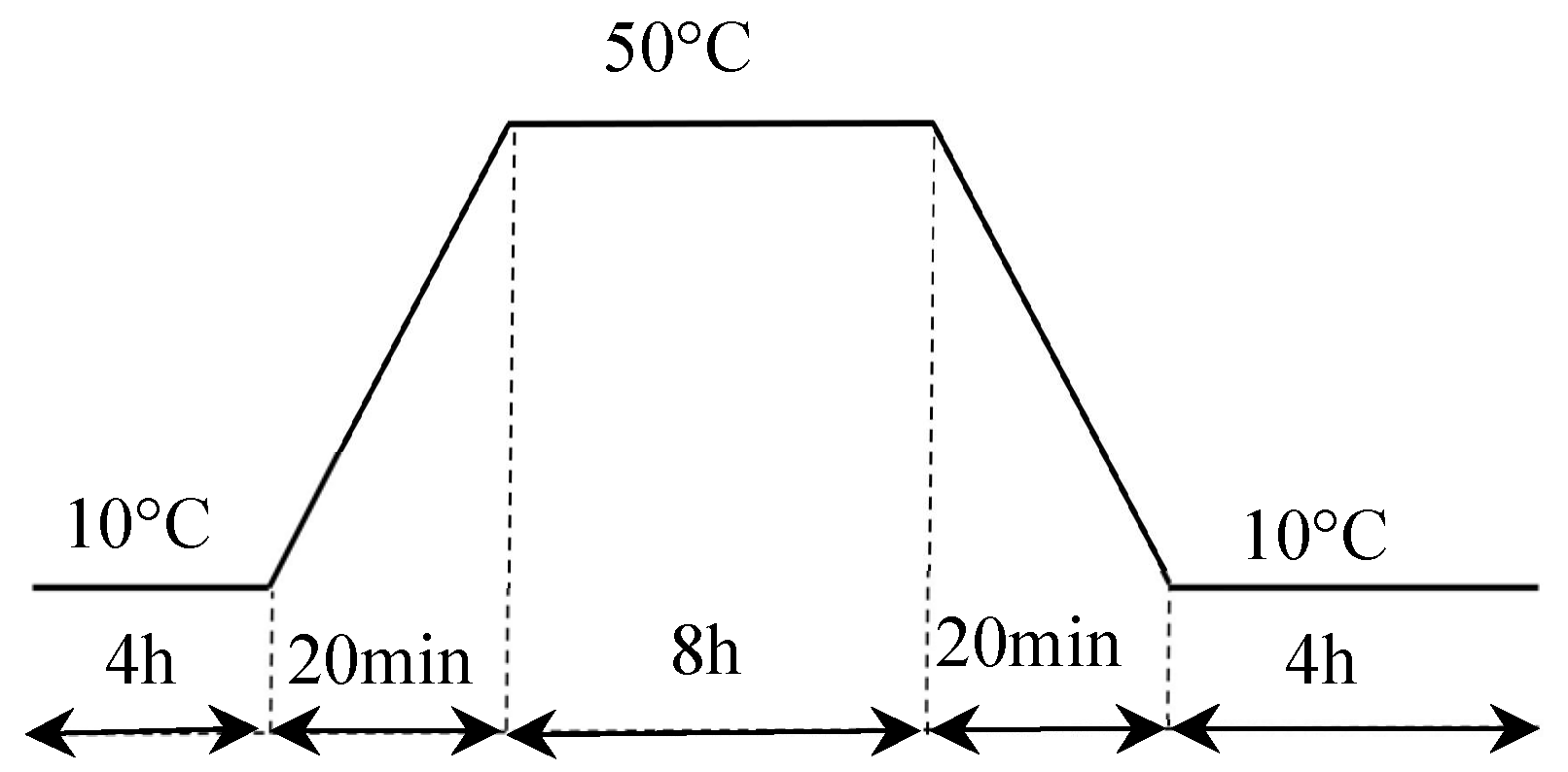
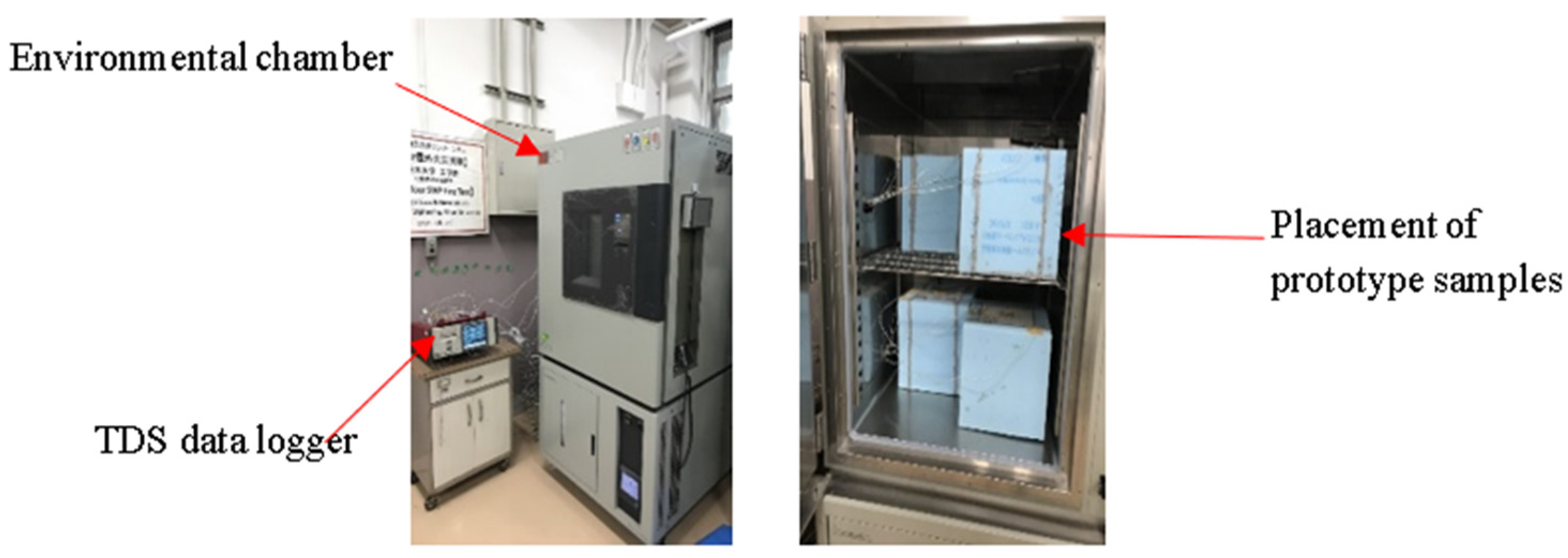








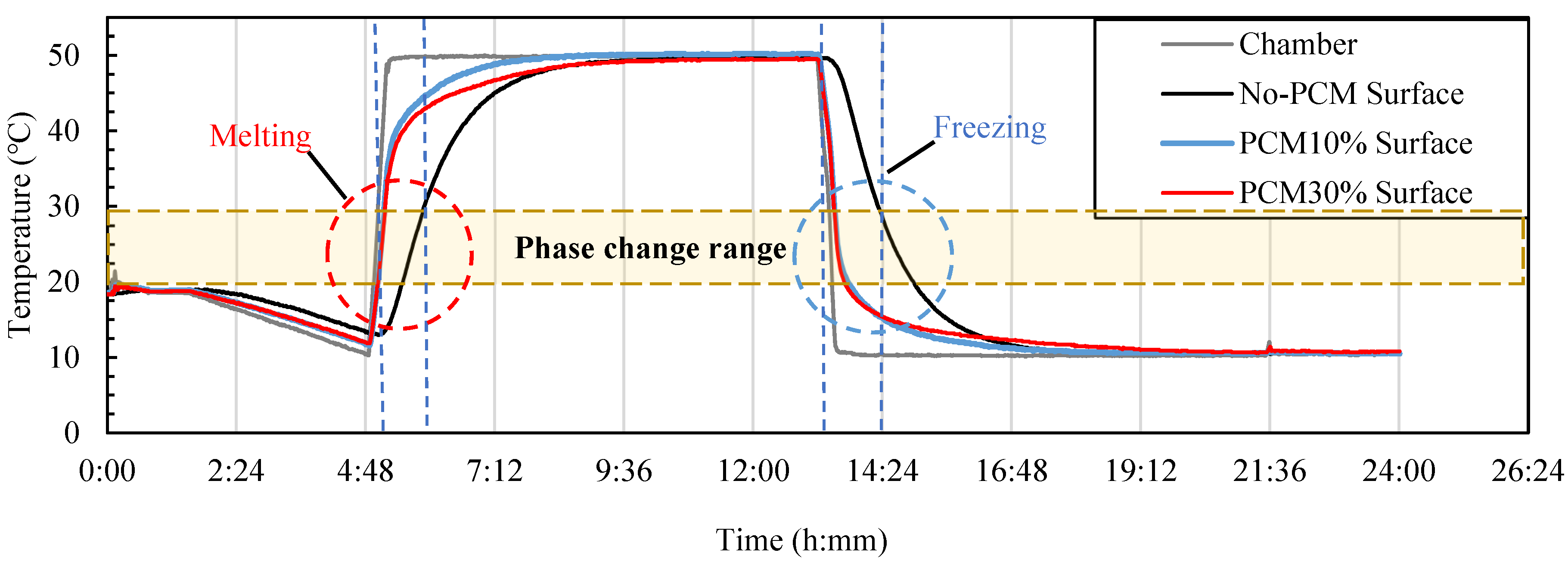
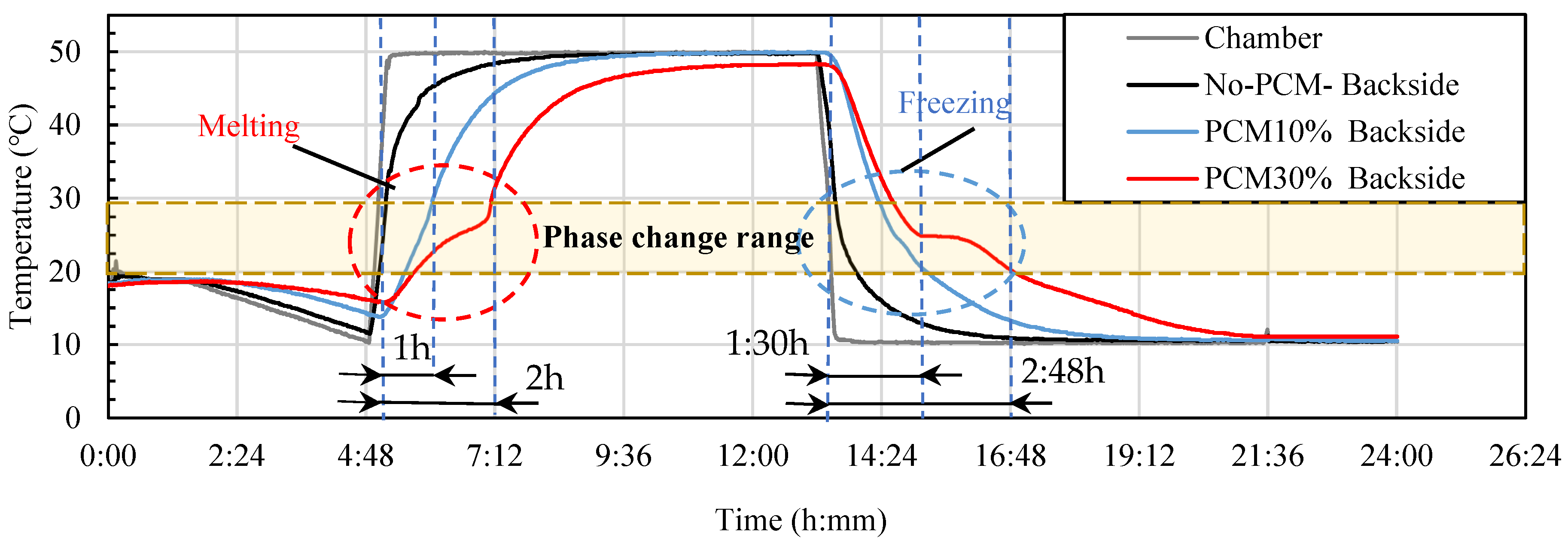
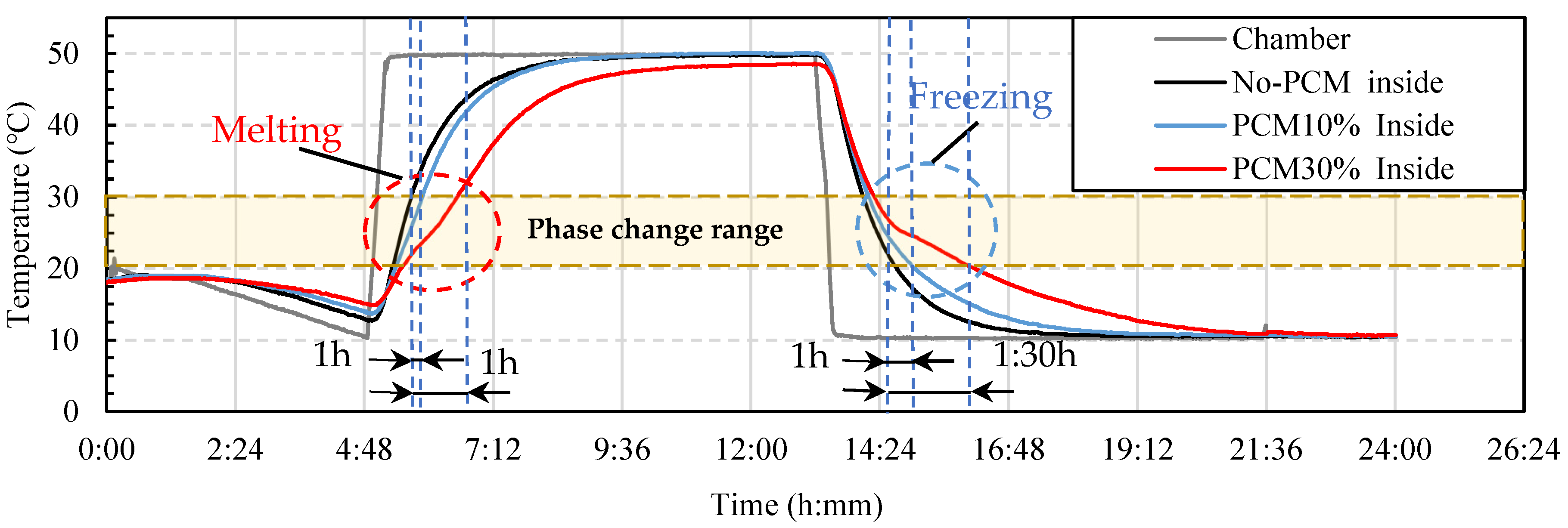
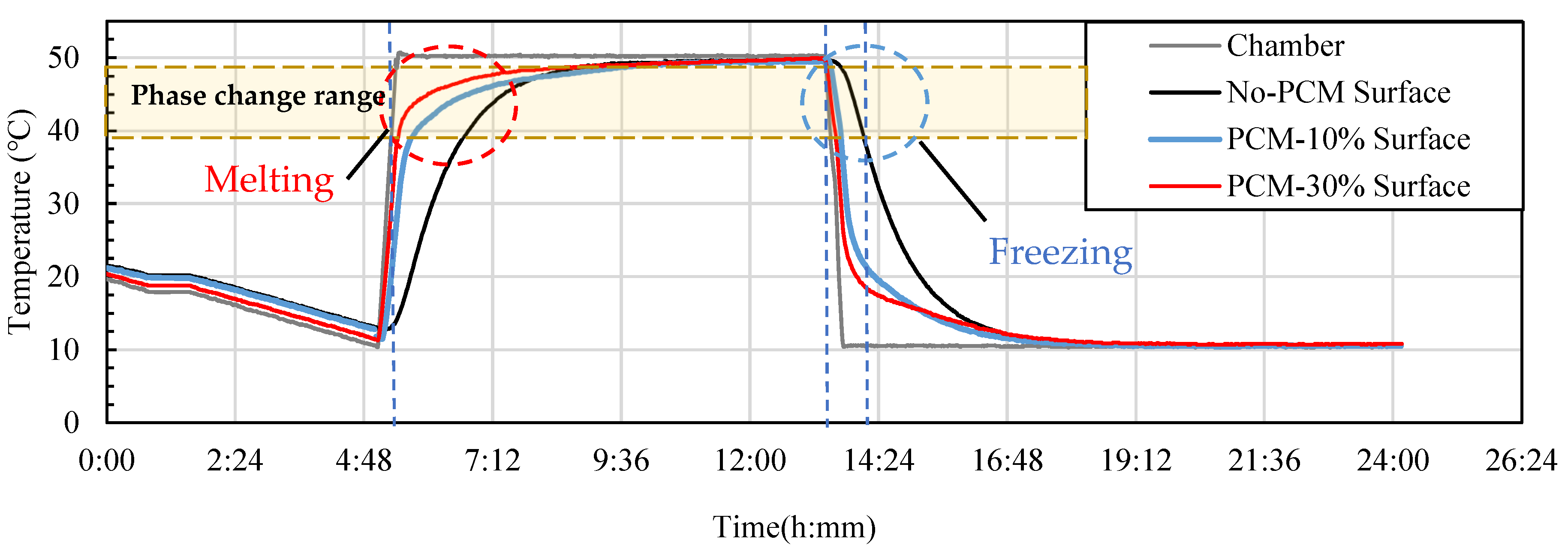


| Material | Nature | Size (μm) | Melting (°C) | Heat of Fusion (J/g) | Solid Content % |
|---|---|---|---|---|---|
| PCM28D | Dry | 15.0–30.0 | 26 to 30 | 189 | 97.0–100.0 |
| PCM43D | Dry | 15.0–30.0 | 41 to 45 | 235 | 97.0–100.0 |
| SO3 | Cl | Na2Oeq | MgO | C3S | C2S | C3A | C4AF | Ig.Loss | |
|---|---|---|---|---|---|---|---|---|---|
| RHC | 2.99 | 0.007 | 0.44 | 1.18 | 64 | 12 | 8 | 8 | 1.05 |
| SIO2 | Al2O3 | Fe2O3 | CaO | MgO | Glass | p (g/cm3) | Ig.Loss | |
|---|---|---|---|---|---|---|---|---|
| Japan FA-II (JIS) | 64.5 | 23.9 | 4.8 | 5.3 | 1.5 | 77.1 | 3.14 | 2.10 |
| Mix Designation | Cement (kg) | Fly Ash (kg) (10%) | W/C (Lit) 0.3 | PCM (kg) 10–30% | SP (kg) 1% | Foam (g) |
|---|---|---|---|---|---|---|
| Reference (0%) | 4.50 | 0.45 | 1.35 | 0 | 0.045 | 310 |
| PCM 28D (10%) | 3.15 | 0.45 | 0.94 | 0.45 | 0.045 | 440 |
| PCM 28D (30%) | 2.25 | 0.45 | 0.67 | 1.35 | 0.045 | 890 |
| PCM 43D (10%) | 3.15 | 0.45 | 0.94 | 0.45 | 0.045 | 430 |
| PCM 43D (30%) | 2.25 | 0.45 | 0.67 | 1.35 | 0.045 | 900 |
| (Density Control) | |||||||
|---|---|---|---|---|---|---|---|
| Mix Designation | (wt.%) | Curing Condition | Curing Period (d) | Fresh Density (kg/m3) | Dry Density (kg/m3) | Consistency (%) | Stability (%) |
| No-PCM | 0 | 40 °C RH-95% | 3 | 1044 | 1021 | 1.0 | 1.0 |
| 7 | 1044 | 1016 | 1.0 | 1.0 | |||
| 14 | 1044 | 1012 | 1.0 | 1.0 | |||
| 28 | 1044 | 1008 | 1.0 | 1.0 | |||
| PCM28D-10% | 10 | 40 °C RH-95% | 3 | 937 | 978 | 0.9 | 1.0 |
| 7 | 937 | 906 | 0.9 | 1.0 | |||
| 14 | 937 | 902 | 0.9 | 1.0 | |||
| 28 | 937 | 883 | 0.9 | 1.1 | |||
| PCM28D-30% | 30 | 40 °C RH-95% | 3 | 1020 | 1038 | 1.0 | 1.0 |
| 7 | 1020 | 879 | 1.0 | 1.2 | |||
| 14 | 1020 | 863 | 1.0 | 1.2 | |||
| 28 | 1020 | 836 | 1.0 | 1.2 | |||
| PCM43D-10% | 10 | 40 °C RH-95% | 3 | 919 | 958 | 0.9 | 1.0 |
| 7 | 919 | 922 | 0.9 | 1.0 | |||
| 14 | 919 | 922 | 0.9 | 1.0 | |||
| 28 | 919 | 906 | 0.9 | 1.0 | |||
| PCM43D-30% | 30 | 40 °C RH-95% | 3 | 1050 | 1034 | 1.1 | 1.0 |
| 7 | 1050 | 918 | 1.1 | 1.1 | |||
| 14 | 1050 | 910 | 0.0 | 0.0 | |||
| 28 | 1050 | 898 | 0.0 | 0.0 | |||
Disclaimer/Publisher’s Note: The statements, opinions and data contained in all publications are solely those of the individual author(s) and contributor(s) and not of MDPI and/or the editor(s). MDPI and/or the editor(s) disclaim responsibility for any injury to people or property resulting from any ideas, methods, instructions or products referred to in the content. |
© 2023 by the authors. Licensee MDPI, Basel, Switzerland. This article is an open access article distributed under the terms and conditions of the Creative Commons Attribution (CC BY) license (https://creativecommons.org/licenses/by/4.0/).
Share and Cite
Bat-Erdene, P.-E.; Pareek, S.; Koenders, E.; Mankel, C.; Löher, M.; Xiao, P. Evaluation of the Thermal Performance of Fly Ash Foam Concrete Containing Phase Change Materials (PCMs). Buildings 2023, 13, 2481. https://doi.org/10.3390/buildings13102481
Bat-Erdene P-E, Pareek S, Koenders E, Mankel C, Löher M, Xiao P. Evaluation of the Thermal Performance of Fly Ash Foam Concrete Containing Phase Change Materials (PCMs). Buildings. 2023; 13(10):2481. https://doi.org/10.3390/buildings13102481
Chicago/Turabian StyleBat-Erdene, Purev-Erdene, Sanjay Pareek, Eddie Koenders, Christoph Mankel, Max Löher, and Peng Xiao. 2023. "Evaluation of the Thermal Performance of Fly Ash Foam Concrete Containing Phase Change Materials (PCMs)" Buildings 13, no. 10: 2481. https://doi.org/10.3390/buildings13102481






